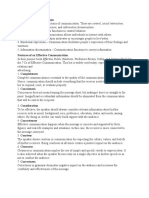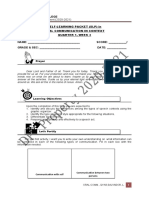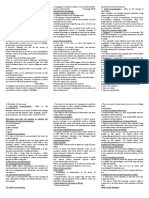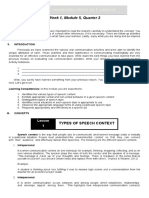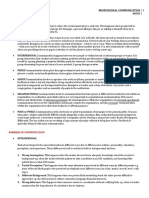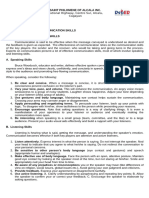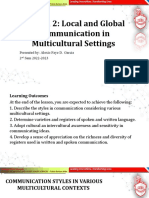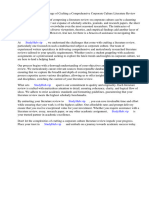Intercultural Communication Speech Act Style Context1
Uploaded by
kyvx58tgydCopyright:
Available Formats
Intercultural Communication Speech Act Style Context1
Uploaded by
kyvx58tgydOriginal Title
Copyright
Available Formats
Share this document
Did you find this document useful?
Is this content inappropriate?
Copyright:
Available Formats
Intercultural Communication Speech Act Style Context1
Uploaded by
kyvx58tgydCopyright:
Available Formats
Intercultural Communication 1.
Intrapersonal – This refers to communication that centers on one person where the
Intercultural communication happens when individuals interact, negotiate, and create speaker acts both as the sender and the receiver of message. .
meanings while bringing in their varied cultural backgrounds (Ting-Toomey, 1999). 2. Interpersonal – This refers to communication between and among people and establishes
Intercultural communication pertains to communication among people from different personal relationship between and among them.
nationalities (Gudykunst, 2003). Types of Interpersonal Communication
Intercultural communication as communication that is influenced by different ethnicities, Dyad Communication – communication that occurs between two people
religions, and sexual orientations. Small Group – This refers to communication that involves at least three but not
Intercultural communication is the sending and receiving of messages across languages and more than twelve people engaging in a face-to-face interaction to achieve a desired goal.
cultures. 3. Public – This type refers to communication that requires you to deliver or send the
Intercultural communication can flow smoothly and become very interesting for a cross- message before or in front of a group. The message can be driven by informational or
cultural group. However, things may not go as planned when communication is disrupted by persuasive purposes
cultural collisions. 4. Mass Communication – This refers to communication that takes place through television,
The Developmental Model of Intercultural Sensitivity radio, newspapers, magazines, books, billboards, internet, and other types of media.
The Developmental Model of Intercultural Sensitivity (DMIS) offers a structure that explores Types of Speech Style
how people experience cultural differences. According to Bennett and Bennett (2004), it has 1. Intimate – This style is private, which occurs between or among close family members or
six stages. These are the following: individuals. The language used in this style may not be shared in public.
Stage 1: Denial. The individual does not recognize cultural differences. 2. Casual – This style is common among peers and friends. Jargon, slang, or the vernacular
Stage 2: Defense. The individual starts to recognize cultural differences and is intimidated by language are used.
them, resulting in either a superior view on own culture or an unjustified high regard for the 3. Consultative – This style is the standard one. Professional or mutually acceptable language
new one. is a must in this style. Examples of situations are communication between teachers and
Stage 3: Minimization. Although individuals see cultural differences, they bank more on the students, employers and employees, doctor and patient, judge and lawyer, or President and
universality of ideas rather than on cultural differences. his/her constituents.
Stage 4: Acceptance. The individual begins to appreciate important cultural differences in 4. Formal – This style is used in formal settings. Unlike the consultative style, this is one-way.
behaviors and eventually in values. Examples are sermons by priests and ministers, State of the Nation Address of the President,
Stage 5: Adaptation. The individual is very open to world views when accepting new formal speeches, or pronouncements by judges.
perspectives. 5. Frozen – This style is “frozen” in time and remains unchanged. It mostly occurs in
Stage 6: Integration. Individuals start to go beyond their own cultures and see themselves ceremonies. Common examples are the Preamble to the Constitution, Lord’s Prayer, and
and their actions based on multifarious cultural viewpoints. Allegiance to country or flag.
Characteristics of Competent Intercultural Communicators -World Bank (2010) Definition of Speech Acts
1. flexibility and the ability to tolerate high levels of uncertainty A speech act is an utterance that a speaker makes to achieve an intended effect. Some of the
2. reflectiveness or mindfulness functions which are carried out using speech acts are offering an apology, greeting, request,
3. open-mindedness complaint, invitation, compliment, or refusal. A speech act might contain just one word or
4. sensitivity several words or sentences. For example, “Thanks” and “Thank you for always being there for
5. adaptability me. I really appreciate it” both show appreciation regardless of the length of the statement.
6. ability to engage in divergent thinking and systems-level thinking Three Types of Speech Act
7. politeness 1. Locutionary act is the actual act of uttering.
Note that in addition to culture, other elements such as gender, age, social status, and 2. Illocutionary act is the social function of what is said.
religion must also be taken into consideration when communicating with others. Refrain from 3. Perlocutionary act is the resulting act of what is said. This effect is based on the particular
showing bias when talking to someone by following the tips below. context in which the speech act was mentioned.
1. Avoid stereotypes, i.e., generalizations about a certain group. Indirect speech acts occur when there is no direct connection between the form of the
2. Challenge gender norms; avoid using “he” and “man” to refer to a general group of utterance and the intended meaning. They are different in force (i.e., intention) from the
people. To remedy this, you may use plural pronouns or rewrite a sentence to avoid inferred speech act.
using pronouns. The use of his/her is also acceptable. Performatives
3. Do not talk down on younger people and the elderly. Austin also introduced the concept of performative utterances: statements which enable the
4. Be sensitive to the religious practices of others. speaker to perform something just by stating it. In this manner, verbs that execute the speech
5. Be polite at all times; do not belittle people you perceive to be on a lower social act that they intend to effect are called performatives. A performative utterance said by the
class than you. right person under the right circumstances results in a change in the world. Note that certain
Types of Speech Context conditions have to be met when making a performative utterance.
You might also like
- Definition and Nature of Intercultural Communication93% (14)Definition and Nature of Intercultural Communication2 pages
- Definition and Nature of Intercultural CommunicationNo ratings yetDefinition and Nature of Intercultural Communication2 pages
- Week 1.: Module 1-Communication and Globalization Overview/ IntroductionNo ratings yetWeek 1.: Module 1-Communication and Globalization Overview/ Introduction45 pages
- Communicative Competence Strategies in Various Speech SituationsNo ratings yetCommunicative Competence Strategies in Various Speech Situations5 pages
- Basic Education Department (2020-2021) Self-Learning Packet (SLP) in Oral Communication in Context Quarter 1, Week 3No ratings yetBasic Education Department (2020-2021) Self-Learning Packet (SLP) in Oral Communication in Context Quarter 1, Week 310 pages
- Communication Can Be Expressed Through Written or Spoken WordsNo ratings yetCommunication Can Be Expressed Through Written or Spoken Words4 pages
- English: Oral Communication: Midterm Handout By: Addu-Shs English TeachersNo ratings yetEnglish: Oral Communication: Midterm Handout By: Addu-Shs English Teachers4 pages
- The Different Types of Speech Context and Speech StyleNo ratings yetThe Different Types of Speech Context and Speech Style2 pages
- Purposive Communication Reviewer MidtermNo ratings yetPurposive Communication Reviewer Midterm9 pages
- Nature of Intercultural Communication: Mario M. SampiloNo ratings yetNature of Intercultural Communication: Mario M. Sampilo15 pages
- Definition and Nature of Intercultural CommunicationNo ratings yetDefinition and Nature of Intercultural Communication3 pages
- Oral Communication Chapter 2 Lesson 1 Types of Speech ContentNo ratings yetOral Communication Chapter 2 Lesson 1 Types of Speech Content47 pages
- ORAL COMM FIRST QUARTER MODULES 5 To 8 RLUSAYNo ratings yetORAL COMM FIRST QUARTER MODULES 5 To 8 RLUSAY52 pages
- Definition and Nature of Intercultural CommunicationNo ratings yetDefinition and Nature of Intercultural Communication15 pages
- Definition and Nature of Intercultural Communication100% (1)Definition and Nature of Intercultural Communication17 pages
- Models of Communication: E. Gestures Are The Most Often Used Type of NonverbalNo ratings yetModels of Communication: E. Gestures Are The Most Often Used Type of Nonverbal2 pages
- BPA A2024-GR1-Communication Processes Principles, and EthicsNo ratings yetBPA A2024-GR1-Communication Processes Principles, and Ethics31 pages
- 10.01.22 Components of The Comm. ProcessNo ratings yet10.01.22 Components of The Comm. Process9 pages
- Module-GEd 106 - Purposive Communication-Pages-1,20-25No ratings yetModule-GEd 106 - Purposive Communication-Pages-1,20-257 pages
- The Nonverbal Factor: Exploring the Other Side of CommunicationFrom EverandThe Nonverbal Factor: Exploring the Other Side of CommunicationNo ratings yet
- B Tech First Year Timetable (JUL-NOV-2023) W.E.F 28 Aug 2023No ratings yetB Tech First Year Timetable (JUL-NOV-2023) W.E.F 28 Aug 202336 pages
- Ielts Academic Reading Practice Test 1 4076721935No ratings yetIelts Academic Reading Practice Test 1 40767219353 pages
- Combined Forced and Natural Convection Heat Transfer in A Deep Lid-Driven Cavity FlowNo ratings yetCombined Forced and Natural Convection Heat Transfer in A Deep Lid-Driven Cavity Flow8 pages
- AGS-Battery Tonic-Battery Distilled Water-SpecificationNo ratings yetAGS-Battery Tonic-Battery Distilled Water-Specification1 page
- One Week Online FDP, 21-27 March 2021 - REVISEDNo ratings yetOne Week Online FDP, 21-27 March 2021 - REVISED9 pages
- Risk and Management Accounting Best Practice GuideNo ratings yetRisk and Management Accounting Best Practice Guide9 pages
- Bombay Teachers' Training College Science Lesson Plan: Page 1 of 14No ratings yetBombay Teachers' Training College Science Lesson Plan: Page 1 of 1414 pages
- Appendix B: A Tutorial On Game Theory For Wireless NetworksNo ratings yetAppendix B: A Tutorial On Game Theory For Wireless Networks38 pages
- Simple Psychology To Get Her Deeply Desiring You For Good George HuttonNo ratings yetSimple Psychology To Get Her Deeply Desiring You For Good George Hutton33 pages
- 5e Official Diseases Lists - 03 - 03 - 21 - GM BinderNo ratings yet5e Official Diseases Lists - 03 - 03 - 21 - GM Binder4 pages





